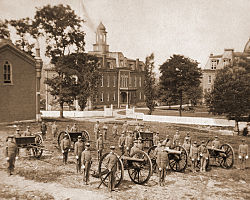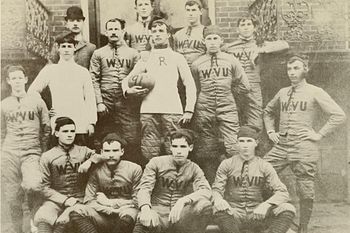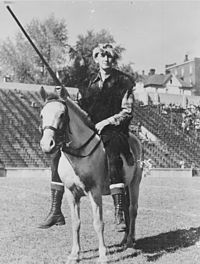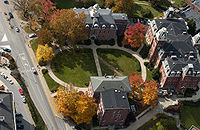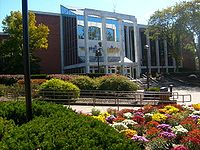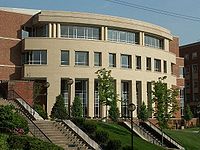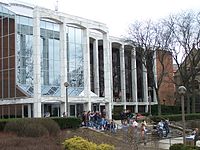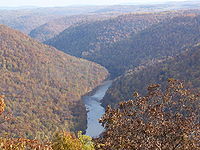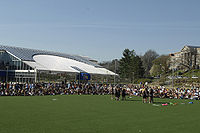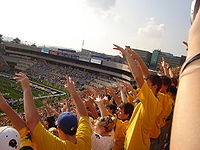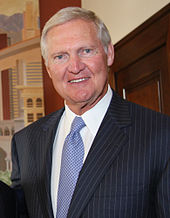- West Virginia University
-
West Virginia University 
Motto ΠΙΣΤΕΙ ΤΗΝ APETHN EN ΔE THI APETHI THN ΓΝΩΣIN Motto in English Add to your faith virtue and to virtue knowledge Established 1867 Type Public land-grant university Endowment $406 million[1] President James P. Clements Provost Michele G. Wheatly Academic staff 1,870 Admin. staff 7,566 Students 29,306 (Fall 2010)[2] Undergraduates 22,303 (Fall 2010)[3] Postgraduates 7,003 (Fall 2010)[3] Location  Morgantown, West Virginia, USA
Morgantown, West Virginia, USA
39°38′09″N 79°57′16″W / 39.63582°N 79.95453°WCoordinates: 39°38′09″N 79°57′16″W / 39.63582°N 79.95453°WCampus Town, 913 acres (3.7 km2) Colors Old gold and Blue [4][5] Athletics NCAA Division I, Big East Conference, 17 varsity teams Nickname Mountaineers Mascot The Mountaineer Website www.wvu.edu 
West Virginia University (WVU) is a public research university in Morgantown, West Virginia, USA. Other campuses include: West Virginia University at Parkersburg in Parkersburg; West Virginia University Institute of Technology in Montgomery; Potomac State College of West Virginia University in Keyser; and a second clinical campus for the University's medical and dental schools at Charleston Area Medical Center in Charleston. Additionally, WVU Extension Service provides outreach with offices in all of West Virginia's 55 counties. Since 2001, WVU has been governed by the West Virginia University Board of Governors.[6]
Enrollment for the Fall 2010 semester was 29,306 for the main campus, while enrollment across all campuses totaled 32,251.[3] The University offers 193 bachelor's, master's, doctoral, and professional degree programs in 15 colleges.[7]
WVU has produced 25 Rhodes Scholars,[7] including former WVU president David C. Hardesty Jr.. The University also has produced 30 Goldwater Scholars, 19 Truman Scholars, five members of USA Today 's All-USA College Academic First Team, and two Morris K. Udall Undergraduate Scholarship winners.[8]
Contents
History
Main article: History of West Virginia UniversityFounding the University
Under the terms of the 1862 Morrill Land-Grant Colleges Act, the West Virginia Legislature created the Agricultural College of West Virginia on February 7, 1867, and the school officially opened on September 2 of the same year.[9][10] On December 4, 1868, lawmakers re-named the college West Virginia University to represent a broader range of higher education.[11] The University was built on the grounds of three former academies, the Monongalia Academy of 1814, the Morgantown Female Academy of 1831, and Woodburn Female Seminary of 1858.[12] Upon its founding, the local newspaper claimed that "a place more eligible for the quiet and successful pursuit of science and literature is nowhere to be found."[10]
The first campus building was constructed in 1870 as University Hall, and was renamed Martin Hall in 1889 in honor of West Virginia University's first president, the Rev. Alexander Martin of Scotland.[13] After the Woodburn Seminary building was destroyed by fire in 1873, the centerpiece of what is now Woodburn Hall was completed in 1876, under the name New Hall. The name was changed to University Building in 1878, when the College of Law was founded as the first professional school in the state of West Virginia.[14] The precursor to Woodburn Circle was finished in 1893 when Chitwood Hall (then Science Hall) was constructed on the bluff's north side. At the turn of the 20th century, a north wing was added to University Building, and the facility was renamed Woodburn Hall. Throughout the next decade, Woodburn Hall underwent several renovations and additions, including the construction of the south wing and east tower housing the iconic Seth Thomas clock.[15] The three Woodburn Circle buildings were listed on the National Register of Historic Places in 1974.[16][17] In 1899, the Vance Farm was acquired for the West Virginia University Experiment Station.[18]
WVU was required to have a Cadet Corps under the terms of the Morrill Act of 1862. The United States War Department offered military equipment to the University at no charge, forming the basis of the school's Military Tactics department. The heavy military influence led to opposition of female enrollment that lasted through the first decade of the University.[19] The trend changed in 1889, when ten women were allowed to enroll and seek degrees at the University. In June 1891, Harriet Lyon became the first woman to receive a degree from West Virginia University, finishing first in the class ahead of all male students.[19] Lyon's academic success supported the acceptance of women in the University as students and educators.[20]
During the University's early years, daily chapel services and roll call for all students were mandatory, limiting time for student recreation. Following the removal of these obligations, students became active in extracurricular activities and established many of the school's first athletic and student organizations. The first edition of the student newspaper known as the Athenaeum, now The Daily Athenaeum, was published in 1887, and the West Virginia Law Review became the fourth oldest law review in the United States when it was founded in 1894.Phi Kappa Psi was the first Fraternity on campus, founded May 23, 1890 . while Kappa Delta, the first sorority at WVU, was established in 1899.[19] The first football team was formed in 1891, and the first basketball team appeared in 1903.[21]
Early 20th century
The University's outlook at the turn of the century was optimistic, as the school constructed the first library in present-day Stewart Hall in 1902.[22] The campus welcomed U.S. President William Taft to campus for WVU President Thomas Hodges's inauguration in 1911.[19] On November 2, 1911, President Taft delivered the address "World Wide Speech," from the front porch of Purinton House.[23] However, the University's efforts to attract more qualified educators, increase enrollment, and expand the campus was hindered during a period that saw two World Wars and the Great Depression. With a heavy military influence in the University, many students left college to join the army during World War I, and the local ROTC was organized in 1916.[24] Women's involvement in the war efforts at home led to the creation of Women's Hall dormitory, now Stalnaker Hall, in 1918.[25]
Despite the wartime struggles, the University was able to establish the disciplines of biology, medicine, journalism, pharmacy, and the first mining program in the nation. In 1918, Oglebay Hall was built to house the expanded agriculture and forestry programs.[24] Additionally, the first dedicated sports facilities were constructed including "The Ark" for basketball in 1918, and the original Mountaineer Field in 1925. Stansbury Hall was built in 1928 and included a new basketball arena named "The Fieldhouse" that held 6,000 spectators.[26] Elizabeth Moore Hall, the woman's physical education building, was also completed in 1928.[27] Men's Hall, the first dormitory built for men on campus, was built in 1935, and was funded in part by the Works Progress Administration.[28] The Mountaineer mascot was adopted during the late 1920s, with an unofficial process to select the Mountaineer through 1936. An official selection process began naming the mascot annually in 1937, with Boyd "Slim" Arnold becoming the first Mountaineer to wear the buckskin uniform.[29]
As male students left for World War II in 1939, women became more prominent in the University and surpassed the number of males on campus for the first time in 1943.[19] Soldiers returning from the war qualified for the G.I. Bill and helped increase enrollment to over 8,000 students for the first time, but the University's facilities were becoming inadequate to accommodate the surging student population.
A campus divided
 An view of the Evansdale campus and many new facilities constructed around 1970, including the iconic WVU Coliseum.
An view of the Evansdale campus and many new facilities constructed around 1970, including the iconic WVU Coliseum.
Preparation for the baby boomer generation and plans for curriculum expansion led to the purchase of land for the Evansdale and Medical campuses. The growth of downtown Morgantown limited the space available on the original campus; therefore, the new site was located nearly two miles north on what had been farmland.[19] Beginning in the late 1950s the University experienced the most rapid period of growth in its history. In 1957, WVU opened a Medical Center on the new campus and founded the first school of dentistry in West Virginia. The basketball program reached a new level of success when the University admitted future 14-time NBA All-Star and Hall of Fame player Jerry West, who led the team to the national championship game in 1959.[30] As enrollment approached 14,000 in the 1960s, the University continued expansion plans by building the Evansdale Residential Complex to house approximately 1,800 students, the Mountainlair student union, and several engineering and creative arts facilities on the Evansdale campus. In 1970 the WVU Coliseum, a new basketball facility with a capacity of 14,000, opened near the new campus.[26] As the facilities continued to expand, the University researched ways to facilitate transportation of its growing student population across the split campuses and to solve its worsening traffic congestion. The resulting Personal Rapid Transit system opened in 1973 as the first automated rapid transit system in the world.[31]
A new era
The student population continued to grow in the late 1970s, reaching 22,000. With no room for growth on the downtown campus, the football stadium was closed, and the new Mountaineer Field was opened near the Medical campus on September 6, 1980.[24] After an eight million-dollar donation to the University, Ruby Memorial Hospital opened on the Medical campus in 1988, providing the state's first level-one trauma center. Early the next year, the undefeated Mountaineer football team, led by Major Harris, made it to the national championship game before losing to Notre Dame in the Fiesta Bowl.
During the 1990s the University developed several recreational activities for students, including FallFest and WVU "Up All Night". While the programs were created to provide safe entertainment for students and to combat WVU's inclusion as one of the top party schools,[32] they also garnered national attention as solutions for reducing alcohol consumption and partying on college campuses across the country.[33][34] In 2001 a 34 million-dollar, 177,000-square-foot (16,400 m2) recreation facility opened on the Evansdale campus, providing students with exercise facilities, recreational activities, and personal training programs.[35]
WVU reached a new level of athletic success during the first decade of the new millennium. The football team featured a 2-0 BCS bowl record, six consecutive bowl game appearances, a #1 ranking in the USA Today Coaches Poll, three consecutive 11-win seasons amassing a 33-5 record, 41 consecutive weeks in the top 25, and 4 conference championships.[36][37] The men's basketball team won the 2007 NIT Championship and the 2010 Big East championship, while appearing four times in the sweet sixteen, twice in the elite-eight, and once in the final-four of the NCAA tournament.[38][39] The athletic successes brought the University a new level of national exposure, and enrollment has since increased to nearly 30,000 students.[40]
On April 24, 2008, the Pittsburgh Post-Gazette reported that the university had improperly granted an MBA degree to Heather Bresch, the daughter of the state's governor Joe Manchin and an employee of Mylan, a pharmaceutical company whose then-chairman Milan Puskar was one of the University's largest donors.[41] In the resulting aftermath, the University determined that Bresch's degree had been awarded without having the prerequisite requirements met and rescinded it, leading to the resignation of president Michael Garrison, provost Gerald Lang, and business school dean Steve Sears. Garrison had been profiled as a trend toward non-traditional university presidents by The Chronicle of Higher Education,[42] and Inside Higher Ed,[43] but the Faculty Senate approved a vote of no confidence in the search that selected him.[44] C. Peter McGrath was named interim president in August 2008.[45] James P. Clements became WVU's 23rd president on June 30, 2009. He previously served as provost at Towson University.[46] On September 16, 2009 Michele G. Wheatly was named Provost and Vice President for Academic Affairs.[47]
Academics
WVU is designated as a Research University (High Research Activity) by the Carnegie Foundation for the Advancement of Teaching.[48] Funding from external sources for total sponsored programs is $174 million.[7] WVU is affiliated with the Blanchette Rockefeller Neurosciences Institute, dedicated to the study of Alzheimer's and other diseases that affect the brain.[49] WVU is also a leader in biometric technology research and the Federal Bureau of Investigation's lead academic partner in biometrics research.[50] According to a survey by the Wall Street Journal, employers ranked West Virginia University in the top 45 and WVU's Engineering program 23rd nationally for producing graduates best qualified to enter the workforce.[51][52]
Colleges and schools
West Virginia University is organized into 15 degree-granting colleges or schools and also offers an Honors College.
- Davis College of Agriculture, Forestry, & Consumer Sciences
- Eberly College of Arts & Sciences
- College of Business & Economics
- College of Creative Arts
- College of Engineering & Mineral Resources
- College of Human Resources & Education
- Perley Isaac Reed School of Journalism
- West Virginia University College of Law
- West Virginia University School of Dentistry
- West Virginia University School of Medicine
- School of Nursing
- School of Pharmacy
- College of Physical Activity & Sports Sciences
- Potomac State College
- WVU Institute of Technology
- Honors College
Eberly College of Arts of Sciences was officially established in 1895. It is home to many academic disciplines including: social and behavioral sciences, literature and the humanities, as well as mathematics and natural resources. It is the largest and most diverse college at WVU.
Areas of study
Forensics and Investigative Science is a nationally recognized program at WVU, originally created through a partnership with the Federal Bureau of Investigation. The program is accredited by the American Academy of Forensic Sciences and is the official library holdings repository for the International Association for Identification. The program focuses on Forensic accounting and fraud, Forensic entomology, Bloodstain pattern analysis and Biological Evidence aging, Criminology and Investigative Science, Dactylography and Fractal Analysis of Fingerprints, Forensic toxicology, Forensic odontology, Computer forensics and Database Research, and Forensic Textile Research. Forensic facilities include "crime-scene" houses and vehicles that can be altered and adapted to give students hands-on experience, as well as traditional laboratories and classrooms which are now housed in the recently[when?] renovated Ming Hsieh Hall adjacent to Oglebay Hall. A separate Criminology & Investigative Sciences major was later added.
Biometrics is an engineering-centric field of study offered at WVU, the first institution in the world to establish a bachelor of science degree in Biometric Systems. In 2003 the University also founded the initial chapter of the Student Society for the Advancement of Biometrics (SSAB).[54] The program, located in the Lane Department of Computer Science and Electrical Engineering (LCSEE), provides a firm understanding of the underlying electrical engineering and computer engineering disciplines that support biometric applications. On February 6, 2008, WVU became the national academic leader for the FBI's biometric research.[55] WVU is also the founding site for the Center for Identification Technology Research (CITeR), focusing on biometrics and identification technology. The university maintains and develops collaborative relationships with other academic institutions to meet research needs.[56]
The Robert C. Byrd Health Sciences Center is located on West Virginia University’s Evansdale Campus and houses the Schools of Dentistry, Medicine, Nursing, and Pharmacy. These schools grant doctoral and professional degrees in 16 different fields, as well as a variety of other Master's and Bachelor's degrees.[57] For 2009, U.S. News and World Report ranked WVU’s Medical School ninth overall in the nation for rural medicine.[58]
Also located on the Health Sciences Campus is WVU's local teaching hospital, Ruby Memorial Hospital, which is one of only two designated Trauma I hospitals in the state and has also been designated a magnet hospital for its ability to attract and retain high quality nursing staff.
Campus
The Morgantown campus comprises three sub-campuses. The original main campus, typically called the Downtown Campus, is in the Monongahela River valley on the fringes of Morgantown. This part of campus includes eight academic buildings on the National Register of Historic Places. The Downtown Campus comprises several architectural styles predominantly featuring red brick including Victorian Second Empire, Federal, Neoclassical, and Collegiate Gothic among others. The Evansdale Campus, a mile and a half north-northwest, on a rise above the flood plain of the Monongahela River, was developed in the 1950s and 1960s to accommodate a growing student population, since space for expansion was limited at the Downtown Campus. The Health Sciences Campus, in the same outlying area (but on the other side of a ridge), includes the Robert C. Byrd Health Sciences Center, the Erma Byrd Biomedical Research Facility, Ruby Memorial Hospital, Chestnut Ridge Hospital, Mary Babb Randolph Cancer Center, WVU Healthcare Physicians Office Center, Blanchette Rockefeller Neurosciences Institute, WVU Eye Institute, and the WVU Children's Hospital.
The Health Sciences Campus is located near Mountaineer Field, over a ridge from the Evansdale Campus.
The West Virginia University Jackson's Mill Center for Lifelong Learning is located near Weston, West Virginia at Jackson's Mill.
Transportation
The Personal Rapid Transit (PRT) system was built to link WVU's distributed campuses (Downtown, Evansdale, and Health Sciences) and to reduce student traffic on local highways. Boeing began construction on the Personal Rapid Transit (PRT) system in 1972. The unique aspect that makes the system "personal" is that a rider specifies their destination when entering the system and, depending on system load, the PRT can dispatch a car that will travel directly to that station.
WVU students, faculty and staff ride by paying a per-semester fee; they swipe their magnetically-encoded ID cards through the turnstiles when entering the stations. Others pay a cash fare of $0.50. The PRT began operation in 1973, with U.S. President Richard Nixon's daughter, Tricia, aboard one of five prototype cars for a demonstration ride.[59] The PRT handles 16,000 riders per day (as of 2005) and uses approximately 70 cars.
The system has 8.7 miles (14.0 km) of guideway track and five stations: Walnut, Beechurst, Engineering, Towers, and Medical/Health Sciences. The vehicles are rubber-tired, but the cars have constant contact with a separate electrified rail. Steam heating keeps the elevated guideway free of snow and ice. Although most students use the PRT, this technology has not been replicated at other sites for various reasons, including the high cost of maintaining the heated track system in winter.[60]
The PRT cars are painted in the school colors (blue with gold trim) and feature the University name and logo on the front. Inside, the seats are light beige fiberglass and the carpeting is blue. Each car has eight seats with an overall capacity of 20 people, including standing room.
The National Society of Professional Engineers named the WVU PRT one of the top 10 engineering achievements of 1972,[59] and in 1997 The New Electric Railway Journal picked the WVU PRT as the best people mover in North America (for 1996).[61]
In 2006, the U.S. Department of Transportation and U.S. Environmental Protection Agency dubbed WVU one of the best workplaces for commuters.[62]
Each autumn, during Mountaineer Week celebrations, a special PRT car is placed in front of the Mountainlair student union where groups of students participate in the "PRT Cram" with the objective of squeezing in as many people as possible. A record of 97 was set in 2000.[63]
Busses and shuttles operated by the University can be utilized (during limited hours) in addition to the community's Mountain Line, which operates every day into the early morning. Students can use their Mountaineer Card to ride the Mountain Line bus for free.
The Health Science Center also operates a shuttle service to help students, visitors and patients to get to and from the Health Science Center campus. Many non-University, private student housing communities in the area also operate a shuttle to campus/town and back to the housing community.
Libraries
The University maintains four libraries on its campuses. These include the Downtown Campus Library, Evansdale Library, Health Sciences Library, and the Law Library. Collections include the Appalachian Collection, Digital Collections, Government Documents, Map Collection, Myers Collection, Patent and Trademarks, Rare Books Collections, and Theses and Dissertations. West Virginia University libraries contain nearly 1.5 million printed volumes, 2.3 million microforms, more than 10,000 electronic journals, and computers with high speed Internet access.[64]
In addition, the West Virginia and Regional History Collection, the world's largest collection of West Virginia related research material, is in the Wise Library on the Downtown Campus. According to the university,[65] the collection includes over 4,500,000 manuscript documents, 30,000 books, 15,000 pamphlets, 1,200 newspapers, 100,000 photographs and prints, 5,000 maps, and 25,000 microfilms, oral histories, films and folk music recordings. It is often called simply the "West Virginia Collection."
In 2007, the Princeton Review ranked West Virginia University libraries 5th best of 366 college libraries surveyed.
The university co-publishes, with the United Association for Labor Education, Labor Studies Journal.
Campus Safety
WVU's campus has been ranked one of the safest in the country by Reader's Digest.[66] The study was largely based on the safety of dorm facilities, emergency preparedness, and security/police staff. The University created WVU Alert, a text-based alert system for quickly disseminating emergency situations to faculty and students.[67] There are 37 blue-lit towers housing emergency phones across the WVU campuses.[68]
Campus Life
Events
FallFest welcomes students to the University by providing an evening of entertainment and musical performances after the first day of classes at the Mountainlair Student Union.[69] The event was established in 1995 to provide a safe alternative to partying and has since become one of the largest University-sponsored events, typically drawing crowds of 15,000 or more.[70] The celebration has been highlighted by a series of evening concerts performed by renowned artists on the Mountainlair green, including Akon, The Black Eyed Peas, Common, Cypress Hill, Dashboard Confessional, Daughtry, Fuel, John Legend, Kanye West, Kris Allen, Ludacris, Maroon 5, Mos Def, O.A.R., The Roots, Staind, Third Eye Blind, Wyclef Jean, and 3 Doors Down.[70] A dance party, film festival, comedy show, and several indoor musical performances are traditionally featured as well.
Mountaineer Week is a celebration of WVU tradition and Appalachian heritage that began in 1947.[71] Festivities have expanded over the years to include competitions among WVU students, designed to honor school and state pride. A beard growing competition was introduced in 1949 that has continued throughout the event's history. Participants must shave before the panel of judges that also chooses the winner at the end of the competition.[72] The Mr. and Ms. Mountaineer competition has been included in Mountaineer Week since 1962, honoring one male and one female student who show outstanding school spirit, academic excellence, and extracurricular involvement. The annual PRT Cram features the unique PRT system, where students compete to fit the maximum number of riders on a special-model PRT car with the windows removed. The record was set in 2000, when 97 students fit inside one PRT car.[71] Mountaineer Idol, a University version of the hit show American Idol, is a relatively new event that begins during Mountaineer Week in September and extends through November. Any WVU student is eligible to enter the competition, which is scored by a panel of guest judges throughout the fall semester.
The Lighting of Woodburn Hall is an annual University ceremony held in early December to light historic Woodburn Hall for the holiday season. The event began in 1987 and is open to the public. Christmas carols are typically sung, and donations are taken at the event to support community organizations. Patients from WVU's Children's hospital are often selected to light Woodburn Hall during the ceremony.[73]
Fall Family Weekend is an opportunity for students' family members to experience WVU campus life by attending classes, athletic events, college presentations, and student events such as WVU "Up All Night". Tours of the campus facilities are offered by individual colleges and organizations, including tours of the PRT.[74]
Homecoming at West Virginia involves a home football game and a weekend of pageantry. Activities include the Alumni Band-led homecoming parade through downtown Morgantown, crowning of the royalty, the football game, and a performance by the WVU Alumni band during the pre-game show. Student organizations participate in the parade by designing floats, and various receptions are held by colleges, student groups, and the alumni center throughout the weekend.[75]
Greek Week is held during the spring semester, providing a venue for competition between Greek organizations. Highlights include airband events, where organizations compete in cheerleading and dance routines, and sports competitions on the Mountainlair recreational field. The competitions strive to highlight WVU's student spirit and present a positive image of the fraternities and sororities.[76]
Recreation
The Mountainlair Student Union, commonly called "the Lair" by students, is the three-floor student union building at WVU. The current building dates to 1968 and replaced an earlier structure built in 1948.[77] The student union offers many recreational opportunities to students including a movie theater, bowling alley, pool hall, ballrooms, video game arcade, a cafeteria style restaurant, and a collection of fast food restaurants.[78]
WVU "Up All Night" is a program designed to provide a safe environment for WVU students to socialize during weekends. The Mountainlair has hosted "Up All Night" every Thursday through Saturday during the fall and spring semesters since 1998.[33] The University provides free food and beverages, and entertainment such as movie screenings at the Gluck Theater, laser tag, game shows, astro bowling, comedy caravans, and casino night. The program has garnered attention from other universities, and WVU administration have been asked to speak about its success at national conferences. Administrators estimate the program's cost at $350,000 annually.[33]
The Student Recreation Center is a 177,000-square-foot (16,400 m2) recreation facility that opened before the 2001 academic year with an initial construction cost of $34 million.[35] The facility offers a six-lane swimming pool, 20-seat Jacuzzi, 17,000 square feet (1,600 m2) of cardio and free-weight equipment, an elevated running track, basketball courts, volleyball and badminton courts, glass squash and racquetball courts, and a 50-foot (15 m) climbing wall.[79] The center also offers a variety of wellness programs, personal training, child care services, exercise classes, and intramural activities.
The Mountaineer Adventure Program (MAP) offers several activities including Adventure WV, Challenge Course, and International Trips. Adventure WV is focused on providing guidance to freshmen and sophomores through various outdoor orientation expeditions. The Challenge Course program utilizes a recreational facility designed to teach teamwork and problem solving skills through physical interaction. International Trips offers world-wide recreational opportunities to places like Fiji and Peru, as well as study abroad credit courses.[80] Several of the MAP programs provide University-accepted credit hours.
The Outdoor Recreation Center is a division of the Student Recreation Center, and facilitates students in finding recreational activities locally and in other areas of West Virginia. Some trips are sponsored by the center including whitewater rafting on the Cheat River and hiking in the Monongahela National Forest.[79] Due to the proximity of WVU's campus to West Virginia's natural wilderness students can rent outdoor recreational equipment for hiking, camping, climbing, fishing, biking, skiing, and whitewater rafting, all of which is available with minimal travel time. The main campus of WVU is situated adjacent to the Monongahela River along which runs the Caperton Trail, a 10-mile (16 km) paved path for walking, running, or biking.[81] Other connecting trails total 43 miles (69 km) in additional length, extending from the Pennsylvania border to Prickett's Fort State Park. Many student groups take day trips to the nearby Coopers Rock State Forest, which is less than 15 miles (24 km) from WVU's campus.[82]
Student organizations
West Virginia University offers more than 300 student-run organizations and clubs. Many of the organizations are associated with academia, religion, culture, military service, politics, recreation, or sports.[83] New student groups may be formed by submitting a constitution and petition to become recognized as a student organization. Descriptions of the larger student groups are listed below.
Student Government Association (SGA) serves as the voice of the student body and is the direct liaison to the University administration. SGA members represent the student interest in University affairs, enacting resolutions to improve student and campus life at WVU. The organization leadership is composed of the President and Vice President acting as an executive body, the Board of Governors representing a legislative branch, and the Athletic Council. Other positions include the Attorney General, Treasurer, Secretary, Off-Campus Housing Director, Public Relations Chair, Elections Chair, and the Executive Director of the Maniacs. All leadership positions are selected from an open, campus-wide election every spring semester.[84]
Mountaineer Maniacs is the largest student-run organization on campus, and the official WVU student section for all athletic events. The demand for membership caused the University to limit enrollment to 3,000 students.[85] The group was founded to promote sportsmanship, increase athletic team awareness, and preserve Mountaineer traditions.[86]
Society of Women Engineers (SWE) encourages the advancement of women in the field of engineering as students, professionals, and leaders. Additionally, SWE strives to help women reach their potential as engineers in the classroom and the workplace. The organization also sponsors events to showcase the field of engineering to young girls including the Girl Scouts.[87]
Fraternities and sororities
Approximately 10-15 percent of West Virginia's students are involved in Greek life. There are 16 fraternities and 8 sororities recognized by WVU.[76][76] Fraternities belonging to the Inter-Fraternity Council and the National Panhellenic Conference include Alpha Gamma Rho, Beta Theta Pi, Kappa Alpha Order, Kappa Sigma, Phi Gamma Delta (FIJI), Phi Delta Theta, Phi Kappa Psi, Phi Sigma Kappa, Pi Kappa Alpha, Pi Kappa Phi, Sigma Alpha Epsilon, Sigma Alpha Mu, Sigma Chi, Sigma Nu, Tau Kappa Epsilon, and Theta Chi. Sororities belonging to the National Panhellenic Conference include Alpha Omicron Pi, Alpha Phi, Alpha Xi Delta, Chi Omega, Delta Gamma, Kappa Kappa Gamma, Pi Beta Phi, and Sigma Kappa. Zeta Delta Phi is also on campus but is not recognized by Panhellenic.
Recently[when?], the University began purchasing some of the fraternity houses near campus, which is a beginning step in a multi-year plan that eventually will leave the University in control of many of the Greek organizations. The Greek organizations who are finding it increasingly difficult to maintain their houses according to Morgantown City Code are getting the repairs and financial support they need. In return, the University is able to govern their behavior.[citation needed]
Student media
The Daily Athenaeum, nicknamed the DA, is the 9th-largest newspaper in West Virginia.[88] Offered free on campus, it generates income through advertisements and student fees. The paper began in 1887 as a weekly literary magazine, with writing, editing and production taken over by the newly formed School of Journalism in the 1920s. In 1970, the paper split from the School of Journalism and became an independent campus entity governed by the Student Publications Board. The DA was voted as the Princeton Review's 10th-best college newspaper in the United States in 2005, 15th in 2006, and 8th in 2007.[89] The Daily Athenaeum is an affiliate of UWIRE, which distributes and promotes its content to their network.[90]
The Mountaineer Jeffersonian is an independent news, economic, and political journal founded by students. Like the DA, it is provided free at multiple locations throughout campus and the Morgantown area. Advertising revenue and private donations are its only source of income. The publication was founded in October 2008 with support from the Leadership Institute and the Collegiate Network and is a continued affiliate of both organizations. Originally printed once a month, it became a weekly publication in 2009. It became a member of the West Virginia Press Association in 2009.[91]
WWVU-FM, called U92 or The Moose, plays new music, talk shows, and newscasts. On the air since 1982, U92 can be heard in the Morgantown area at 91.7 FM and also streams live on the internet. In 2007, the station was one of four college radio stations nominated for College Music Journal's Station of the Year Award.[92]
Student health
The Student Center of Health, also known under the label "Well WVU", provides services related to student health, disease prevention, and awareness. The Carruth Center for Psychological and Psychiatric Services offers therapy to any WVU student.[93] The Robert C. Byrd Health Science Center and the associated West Virginia University Hospitals, located on the Health Science Campus, serve as West Virginia's largest healthcare institution.[94] The hospitals provide a comprehensive set of healthcare needs for local and regional patients. WVU students are provided with full access to the healthcare resources, which are accessible from the PRT medical station.
Arts and entertainment
WVU Arts&Entertainment (A&E) sponsors entertainment events for students throughout the academic year. The department organizes the annual FallFest event, which features popular musicians, comedians, and other performers. WVU A&E annually hosts several concerts at the WVU Coliseum and Creative Arts Center, with past performances by Akon, The All-American Rejects, The Fray, Kelly Clarkson, Ludacris, Maroon 5, Reba McEntire, Willie Nelson and 50 Cent among others.[70]
The West Virginia Public Theater (WVPT) is one of two professional musical theaters in West Virginia. The group is located near WVU's campus and performs several Broadway numbers yearly.[95]
The Art Museum of West Virginia University is under construction on the Evansdale Campus next to the college of Creative Arts. The completed 5,300-square-foot (490 m2) facility will feature touring exhibitions of at least 2,500 works of art from the Appalachian region, Asia, and Africa.[96]
Athletics
The school's sports teams are called the Mountaineers and compete in the NCAA's Division I. The school has teams in 17 college sports and has won several national championships, including 14 NCAA Rifle Championships as of 2009.[97] Although the Mountaineers are currently full members of the Big East Conference in all sports, on October 28, 2011, the school accepted an invitation to join the Big 12 Conference, ostensibly beginning with the 2012 season.[98] However, the actual start date of West Virginia University's departure from the Big East and inclusion in the Big 12 is currently being decided in court.[99][100]
Notable athletes from West Virginia University include Stan "The Man" Boskovich, Jerry West, Jim Braxton, Marc Bulger, Avon Cobourne, Mike Compton, Noel Devine, Cecil Doggette, Mike Gansey, Major Harris, Chris Henry, Joe Herber, Jeff Hostetler, Chuck Howley, Sam Huff, Darryl Talley, "Hot Rod" Hundley, Adam "Pacman" Jones, Joe Stydahar, Dan Mozes, Kevin Pittsnogle, Jerry Porter, Todd Sauerbrun, Steve Slaton, Rod Thorn, Mike Vanderjagt, Pat White, Quincy Wilson, Amos Zereoue, Greg Jones, Joe Alexander, Owen Schmitt, and Georgann Wells, the first female player to register a dunk in a collegiate basketball game.[101]
Football
With a 691–453–45 record, West Virginia is the winningest Football Bowl Subdivision (FBS) team to have never won a national championship.[102] WVU has had two undefeated regular seasons; they went 11-0 in 1988 and 1993. However, West Virginia lost both bowl games, 34–21 to Notre Dame in the National Championship, and 41–7 to Florida. The 2005 season and the 2006 season produced the first consecutive 11-win seasons in school history.[103] In the 2007 season, the Mountaineers started the season as the #3-ranked team, the highest preseason ranking in school history. That team eventually was ranked #1 in the Coaches Poll, and finished the season with a third consecutive 11-win season after their Fiesta Bowl victory.
Basketball
West Virginia men's basketball has competed in three basketball championship final matches: the 1959 NCAA final, the 1942 NIT final (at that time, the NIT was considered more prestigious than the NCAA), and the 2007 NIT Championship. They lost 71–70 to California in the 1959 final NCAA finals, while the Mountaineers won the 1942 NIT Championship 47–45 over Western Kentucky, and the 2007 NIT contest over Clemson 78–72 in a rebuilding season. In 1949, future Mountaineers head coach, Fred Schaus, became the first player in NCAA history to record 1,000 points.
West Virginia most recently reached the Final Four of the 2010 NCAA Men's Division I Basketball Tournament, led by West Virginia coach and former WVU player Bob Huggins. The Mountaineers are the current Big East Conference champions, and received a #2 seed in the East Region of the 2010 NCAA Men's Division I Basketball Tournament.
Marching band
Main article: West Virginia University Mountaineer Marching BandThe West Virginia University Mountaineer Marching Band, nicknamed "The Pride of West Virginia," is the official marching band of WVU. The 390-member band performs at every home football game and makes several local and national appearances throughout the year. The band was the recipient of the prestigious Sudler Trophy in 1997.
Fanbase
In a state that lacks professional sports franchises, the citizens of West Virginia passionately support West Virginia University and its athletics teams.[104] Men's basketball head coach Bob Huggins, a former Mountaineer basketball player who was born in Morgantown, stated that the "strong bond between the university and the people of West Virginia" is a relationship that is difficult for non-natives to understand.[105] Former basketball player Da'Sean Butler cited the fan support as a factor in his decision to play for WVU, saying "everybody loves our school to death" in reference to the fan base in West Virginia.[106]
West Virginia fans have also been recognized for their hospitality. In the first football game played by the University of Connecticut following the death of Jasper Howard, a banner displayed at Mountaineer Field in the Connecticut entrance tunnel read "Today we are all Huskies". Connecticut fans described the warmth of the environment as impressive, citing the number of WVU fans who offered condolences.[107] In a letter to WVU, then UConn head football coach Randy Edsall wrote:
"The response that you gave our team before and after the game was tremendous and greatly appreciated. The pregame moment of silence and team handshake was the most moving experience I have ever had in my 29 years of coaching football." [108]
The Mountaineer Maniacs is the largest student-run organization on campus, and the official WVU student section for all athletic events. The group was founded to promote sportsmanship, increase athletic team awareness, and preserve Mountaineer traditions.[109]
Some WVU fans, primarily in the student sections, have developed a reputation for unruly behavior, being compared to "soccer hooligans" by GQ magazine.[110][111] At some events, there have been cases of objects thrown onto the field or at opposing teams.[112][113] There were previously also issues with small-scale fires, most notably of couches, being set after games; over 1,100 intentionally-ignited street fires were reported from 1997 to 2003.[110]
Pageantry
The Mountaineer was adopted in 1890 as the official school mascot and unofficially began appearing at sporting events in 1936.[114] A new Mountaineer is selected each year during the final two men's home basketball games, with the formal title "The Mountaineer of West Virginia University." The new Mountaineer receives a scholarship, a tailor-made buckskin suit with coonskin hat, and a period rifle and powder horn for discharging when appropriate and safe. The mascot travels with most sports teams throughout the academic year. While not required, male mascots traditionally grow a beard.
The "Flying WV" is the most widely used logo in West Virginia athletics. It debuted in 1980 as a part of a football uniform redesign by Coach Don Nehlen, and was adopted as the official logo for the University in 1983.[115] While the "Flying WV" represents all university entities, unique logos are occasionally used for individual departments. Some examples include the script West Virginia logo for the WVU Department of Intercollegiate Athletics, and the interlocking WV logo used in baseball.[116]
Fight songs of West Virginia University include "Hail, West Virginia" and "Fight Mountaineers." However, the fan response to John Denver's "Country Roads" has made it the unofficial song of the university and the state of West Virginia. The West Virginia University Alma Mater was composed in 1937, and is sung before every home football game. The crowd sings along as the WVU Marching Band stands playing it on the field, as part of the pre-game show.
Old gold and blue, the official University colors, were selected by the upperclassmen of 1890 from the West Virginia state seal.[114] While the official school colors are old gold and blue, a brighter gold is used in official university logos and merchandise. This change in color scheme is often cited for the lack of a universal standard for colors during 19th century when the university's colors were selected. Additionally, the brighter gold is argued to create a more intimidating environment for sporting events. The university accepts "gold and blue" for the color scheme, but states clearly that the colors are not "blue and gold", to distinguish West Virginia from its rival school the University of Pittsburgh.
Sports Traditions
"Country Roads" has become the unofficial song of the University and the state of West Virginia.[117] In 1980 John Denver performed his hit song "Take Me Home, Country Roads" at the dedication of Mountaineer Field, and it has since become tradition for fans to remain in the stands following every Mountaineer victory and sing the song with the players. Although the tradition originated during football games, it is now recognized throughout the University, with the song being performed at various athletic events and ceremonies. Sports Illustrated named the singing of "Country Roads" as one of the must-see college traditions.[118]
The Pride of West Virginia is the official marching band of the University. The band's football pre-game show includes traditions such as the Drumline's "Tunnel" and "Boogie" cadences, the 220-beat per minute run-on cadence to start the performance, marching the "WV" logo down field to the University fight song, "Fight Mountaineers," expanding circles during Simple Gifts, and the formation of the state's outline during "Hail, West Virginia".
The Firing of the Rifle is a tradition carried out by the Mountaineer Mascot to open several athletic events. The Mountaineer points the gun into the air with one arm and fires a blank shot from a custom rifle, a signal to the crowd to begin cheering at home football and basketball games. The Mountaineer also fires the rifle every time the team scores during football games.
The Carpet roll is a WVU Men's Basketball tradition. In 1955, Fred Schaus and Alex Mumford devised the idea of rolling out an elaborate gold and blue carpet for Mountaineer basketball players to use when taking the court for pre-game warm-ups. In addition, Mountaineer players warmed up with a special gold and blue basketball. The University continued this tradition until the late 1960s when it died out, but former Mountaineer player Gale Catlett reintroduced the carpet when he returned to West Virginia University in 1978 as head coach of the men's basketball team.
Notable alumni
West Virginia alumni total approximately 170,000, and live in over 60 nations.[119]
Notable alumni include NBA logo and hall-of-fame NBA player Jerry West, five-time Emmy Award-winning American actor Don Knotts, American film director Antoine Fuqua, former Supreme Allied Commander Europe and U.S. European Commander Bantz J. Craddock, youngest General in U.S. Marines history Earl E. Anderson, President Emeritus of the Massachusetts Institute of Technology Charles M. Vest, President and CEO of Cisco Systems John Chambers, former West Virginia Governor Joe Manchin, present West Virginia Governor Earl Ray Tomblin, and journalist Michael Tomasky.[119]
References
- ^ As of June 30, 2010. "The College Sustainability Report Card" (PDF). 2011 Green Report. Sustainable Endowments Institute. http://www.greenreportcard.org/report-card-2011/schools/west-virginia-university. Retrieved February 23, 2011.
- ^ "WVU fall enrollment breaks several records". The Charleston Gazette. http://sundaygazettemail.com/News/201010201366. Retrieved October 21, 2010.
- ^ a b c "WVU enrollment at record levels across all campuses; minority, international, transfer gains in Morgantown". West Virginia University. http://wvutoday.wvu.edu/n/2010/10/20/minority-overall-enrollment-increases-at-wvu. Retrieved October 21, 2010.
- ^ "WVU Communications Guide" (PDF). West Virginia University. 2009. p. 10. http://creativeservices.wvu.edu/r/download/10258.
- ^ "School Colors". West VIrginia University Alumni Association. April 15, 2010. http://alumni.wvu.edu/traditions/school_colors.
- ^ WVU.edu: Board of Governors - "Powers & Duties"
- ^ a b c "WVU Facts". West Virginia University. http://about.wvu.edu/facts. Retrieved March 15, 2010.
- ^ Morris K. Udall Foundation
- ^ Doherty, William T.; Festus P. Summers (1982). West Virginia University: Symbol of Unity in a Sectionalized State. West Virginia University Press. p. 8. ISBN 0937058165.
- ^ a b "West Virginia College". Morgantown Weekly Post. 8-10-1867. http://www.wvculture.org/history/education/wvu01.html. Retrieved 8-16-2010.
- ^ Doherty, William T.; Festus P. Summers (1982). West Virginia University: Symbol of Unity in a Sectionalized State. West Virginia University Press. p. 11. ISBN 0937058165.
- ^ "About Monongalia County". WVU Extension Services. http://monongalia.ext.wvu.edu/about_monongalia_county. Retrieved 08-17-2010.
- ^ "A Brief History of Marin Hall". West Virginia University. http://journalism.wvu.edu/about_us/about_martin_hall. Retrieved 08-17-2010.
- ^ "WVU College of Law History". WVU College of Law. http://law.wvu.edu/about_us/deans_message/history. Retrieved 08-18-2010.
- ^ "Woodburn Hall, WVU's Historic Centerpiece". West Virginia University. http://www.ia.wvu.edu/~magazine/issues/fall2001/htmlfiles/woodburn.html. Retrieved 08-17-2010.
- ^ "National Register Information System". National Register of Historic Places. National Park Service. 2010-07-09. http://nrhp.focus.nps.gov/natreg/docs/All_Data.html.
- ^ George A. Smyth, Ted McGee, and James E. Harding (February 1974). "National Register of Historic Places Inventory Nomination Form: Woodburn Circle". State of West Virginia, West Virginia Division of Culture and History, Historic Preservation. http://www.wvculture.org/shpo/nr/pdf/monongalia/74002014.pdf. Retrieved 2011-08-18.
- ^ Lee R. Maddex (January 1991). "National Register of Historic Places Inventory Nomination Form: Vance Farmhouse". State of West Virginia, West Virginia Division of Culture and History, Historic Preservation. http://www.wvculture.org/shpo/nr/pdf/monongalia/91001731.pdf. Retrieved 2011-08-18.
- ^ a b c d e f "West Virginia University: 1867-2003". West Virginia University. http://wvuhistory.wvu.edu/historyofwvu. Retrieved 08-17-2010.
- ^ WVU Student Government (2007). "8". Dream Big, Dream Here. Tapestry Press. ISBN 1598301500.
- ^ "A History of the Integration of Sports at WVU". West Virginia University. http://sportsintegration.wvu.edu/index.html. Retrieved 08-17-2010.
- ^ Rodney S. Collins (March 1980). "National Register of Historic Places Inventory Nomination Form: Stewart Hall". State of West Virginia, West Virginia Division of Culture and History, Historic Preservation. http://www.wvculture.org/shpo/nr/pdf/monongalia/80004034.pdf. Retrieved 2011-08-18.
- ^ Randall Gooden (July 1985). "National Register of Historic Places Inventory Nomination Form: Purinton House". State of West Virginia, West Virginia Division of Culture and History, Historic Preservation. http://www.wvculture.org/shpo/nr/pdf/monongalia/85003206.pdf. Retrieved 2011-08-18.
- ^ a b c "WVU Year-by-Year". West Virginia University. http://www.ia.wvu.edu/~magazine/issues/winter2000/html%20files/yearbyyear.html. Retrieved 08-19-2010.
- ^ Randall Gooden (July 1985). "National Register of Historic Places Inventory Nomination Form: Stalnaker Hall". State of West Virginia, West Virginia Division of Culture and History, Historic Preservation. http://www.wvculture.org/shpo/nr/pdf/monongalia/85003205.pdf. Retrieved 2011-08-18.
- ^ a b Bill Bradley (2009). ESPN College Basketball Encyclopedia: The Complete History of the Men's Game. ESPN. p. 36. ISBN 0345513924.
- ^ Randall Gooden (July 1985). "National Register of Historic Places Inventory Nomination Form: Elizabeth Moore Hall". State of West Virginia, West Virginia Division of Culture and History, Historic Preservation. http://www.wvculture.org/shpo/nr/pdf/monongalia/85003208.pdf. Retrieved 2011-08-18.
- ^ Stanley Bumgardner and Barbara J. Howe (January 1989). "National Register of Historic Places Inventory Nomination Form: Men's Hall". State of West Virginia, West Virginia Division of Culture and History, Historic Preservation. http://www.wvculture.org/shpo/nr/pdf/monongalia/89002309.pdf. Retrieved 2011-08-18.
- ^ "The Mountaineer". MSN Sports. http://msnsportsnet.com/page.cfm?section=9614. Retrieved 08-19-2010.
- ^ "NBA Encyclopedia Playoff Edition". ESPN. http://www.nba.com/history/players/west_bio.html. Retrieved 08-20-2010.
- ^ "Still in a Class of Its Own". Progressive Engineer. http://www.progressiveengineer.com/PEWebBackissues2002/PEWeb%2024%20Mar%2002-2/PRT.htm. Retrieved 08-20-2010.
- ^ "List of Party Schools By Princeton Review". Associated Press. http://www.brandonsun.com/world/breaking-news/list-of-top-party-schools-by-princeton-review-99770794.html?thx+y. Retrieved 08-13-2010.[dead link]
- ^ a b c "WVU officials say program worth the cost". Charleston Daily Mail. http://www.allbusiness.com/education-training/students-student-life/14364607-1.html. Retrieved 08-12-2010.
- ^ Party Response
- ^ a b "Amazing New Rec Center". Charleston Gazette. http://www.facilityplanners.com/ht/a/GetDocumentAction/i/3949. Retrieved 08-13-2010.
- ^ "A Championship Program". MSN Sports Net. http://www.msnsportsnet.com/page.cfm?sport=football&show=65. Retrieved 08-20-2010.
- ^ "2007 NCAA Football Rankings - Week 14 (Nov. 25)". ESPN/AP. http://espn.go.com/college-football/rankings/_/year/2007/week/14. Retrieved 08-20-2010.
- ^ "2007 NIT Champions". NIT. http://www.msnsportsnet.com/page.cfm?sport=mbball&show=25. Retrieved 08-20-2010.
- ^ "Tradition of Champions". MSN Sports Net. http://www.nit.org/sports/m-nit/recaps/032907aaa.html. Retrieved 08-20-2010.[dead link]
- ^ "WVU set record fall enrollment". West Virginia University. http://wvutoday.wvu.edu/n/2009/8/26/7986. Retrieved 08-20-2010.
- ^ Ian Urbina, "University Investigates Whether Governor’s Daughter Earned Degree", New York Times, 22 January 2008
- ^ "The Lobbyist as President," by Paul Fain, Chronicle of Higher Education, February 15, 2008.
- ^ "The Non-Traditional President," Insidehighered.com, March 14, 2008
- ^ Daily Athenaeum (May 23, 2007): "Faculty Senate votes 'no confidence'", by Tricia Fulks
- ^ WVU Admin
- ^ "WVU's 23rd president officially takes reins"
- ^ "Wheatly named Provost at WVU"
- ^ Carnegie Classifications
- ^ Blanchette Rockefeller Neurosciences Institute - Welcome
- ^ About WVU | Recognition | West Virginia University
- ^ "Wall Street Journal Employer Rankings By Major". The Wall Street Journal. September 14, 2010. http://online.wsj.com/article/SB10001424052748703376504575491704156387646.html?mod=WSJ_article_RecentColumns_PathtoProfession. Retrieved 9-17-2010.
- ^ "Wall Street Journal Employer Rankings: The Next Twenty". The Wall Street Journal. September 13, 2010. http://online.wsj.com/article/SB10001424052748703369704575462023026245534.html?mod=WSJ_article_RecentColumns_PathtoProfession. Retrieved 9-17-2010.
- ^ "Stalnaker Hall". West Virginia University. Archived from the original on 2009-02-06. http://www.webcitation.org/5eNaoAnsl. Retrieved 2009-02-06.
- ^ SSAB WVU Chapter
- ^ FBI Press
- ^ CITeR
- ^ "Majors Listed by College & School". West Virginia University. http://www.wvu.edu/majors/index.html. Retrieved 2008-11-24.
- ^ usnews.com: Medical Specialty Rankings: Rural medicine
- ^ a b WVU News and Information Services (July 13, 2004 press release): "WVU PRT Station to Bear Name of People-Mover's Creator"
- ^ "Some Lessons from the History of Personal Rapid Transit (PRT)". University of Washington. http://faculty.washington.edu/jbs/itrans/history.htm. Retrieved 08-25-2010.
- ^ "Rating the Rails" (annual performance-ratings feature by transit mode), The New Electric Railway Journal, Spring 1997, p. 30.
- ^ "WVU Named One of 'Best Workplaces' for Commuters by EPA, DOT
- ^ Wolfe, Billy (2005-11-01). "PRT Cram". The Daily Athenaeum. http://www.da.wvu.edu/show_article.php?&story_id=19842. Retrieved 2007-11-06.
- ^ West Virginia Collection Welcome Page
- ^ West Virginia Collection General Information
- ^ "College Safety Survey Results". Reader's Digest. http://www.rd.com/images/content/2008/0802/College-Safety-Survey-Results.pdf. Retrieved 08-12-2010.
- ^ "WVU Emergency Information". West Virginia University. http://emergency.wvu.edu. Retrieved 08-12-2010.
- ^ "WVU Police". West Virginia University. http://police.wvu.edu/home/clery_report. Retrieved 08-12-2010.
- ^ "Daughtry to headline WVU FallFest 2008". West Virginia University. http://wvutoday.wvu.edu/n/2008/08/14/7034. Retrieved 8-12-2010.
- ^ a b c "WVU hosts annual back to school bash at the Mountainlair". WBOY. http://wboy.com/story.cfm?func=viewstory&storyid=42748. Retrieved 8-12-2010.
- ^ a b "WVU Mountaineer Week". West Virginia University. http://mountaineerweek.wvu.edu. Retrieved 8-12-2010.
- ^ "WVU's Beard Growing Contest". WBOY. http://wboy.com/story.cfm?func=viewstory&storyid=70123. Retrieved 8-12-2010.
- ^ "WVU Lights Historic Woodburn Hall". WBOY. http://wboytv.com/story.cfm?func=viewstory&storyid=47818. Retrieved 8-12-2010.
- ^ "Mountaineer Parents Club Fall 2009". WVU Mountaineer Parents Club. http://parentsclub.wvu.edu/r/download/40479. Retrieved 8-12-2010.
- ^ "WVU homecoming". West Virginia University. http://homecoming.wvu.edu/. Retrieved 8-12-2010.
- ^ a b c "WVU Fraternity Recruitment". West Virginia University. http://www.wvufraternityrecruitment.org. Retrieved 08-11-2010.
- ^ Zeller, Karen (Summer 1998). "Mountainlair Turns 50". West Virginia University Alumni Magazine. (West Virginia University) 21 (2). http://www.ia.wvu.edu/~magazine/sum98/mountain.html. Retrieved 2008-11-12.
- ^ "The Lair". West Virginia University. http://mountainlair.wvu.edu. Retrieved 08-12-2010.
- ^ a b "WVU Recreation Center". West Virginia University. http://studentreccenter.wvu.edu/about_the_rec_center. Retrieved 08-12-2010.
- ^ "WVU Mountaineer Adventure Program". West Virginia University. http://mountaineeradventureprogram.wvu.edu/. Retrieved 08-12-2010.
- ^ "Mon River Trails Conservatory". Monongalia County. http://www.montrails.org/maps.shtml. Retrieved 08-12-2010.
- ^ "Coopers Rock State Forest". WV State Parks. http://www.coopersrockstateforest.com/. Retrieved 08-12-2010.
- ^ "WVU Student Organization Services". West Virginia University. http://sos.wvu.edu. Retrieved 8-11-2010.
- ^ "WVU Student Government Association". West Virginia University. http://sga.wvu.edu. Retrieved 08-11-2010.
- ^ "WVU Student Tickets". West Virginia University. http://studenttickets.wvu.edu. Retrieved 08-11-2010.
- ^ "WVU Maniacs". West Virginia University. http://maniacs.wvu.edu. Retrieved 08-02-2010.
- ^ "WVU Society of Women Engineers". West Virginia University. http://maniacs.wvu.edu. Retrieved 08-11-2010.
- ^ "Daily Athenaeum 2007-2008 Rate Card". West Virginia University DA. http://www.da.wvu.edu/new/print_edition/rate_card/rate_card_07_08.pdf. Retrieved 08-11-2010.
- ^ "Princeton Review Homepage". Princeton. http://www.princetonreview.com. Retrieved 08-11-2010.
- ^ "UWIRE affiliates". UWIRE. http://www.uwire.com/content/affiliates.html. Retrieved 08-11-2010.[dead link]
- ^ "WV Press members". WV Press. http://www.wvpress.org/associatemembers.html. Retrieved 08-11-2010.
- ^ "College Music Journal Press Release". College Music Journal. http://prod1.cmj.com/articles/display_article.php?id=49047299. Retrieved 09-31-2007.
- ^ "WellWVU, Student Center for Health". West Virginia University. http://www.well.wvu.edu. Retrieved 08-13-2010.
- ^ "West Virginia University Hospitals". West Virginia University. http://health.wvu.edu/general/Healthcare/WVUH.aspx. Retrieved 08-13-2010.
- ^ "West Virginia Public Theater". West Virginia Public Theater. http://www.wvpublictheatre.com/education.html. Retrieved 08-13-2010.
- ^ "The Art Museum of WVU". West Virginia University. http://www.ccarts.wvu.edu/art_museum. Retrieved 08-13-2010.
- ^ NCAA Sports: Rifle History
- ^ http://www.big12sports.com/ViewArticle.dbml?DB_LANG=C&DB_OEM_ID=10410&ATCLID=205323383&SPID=13138&SPSID=106137
- ^ [1]
- ^ [2]
- ^ Morgantown Dominion Post (Dec. 23, 1984): "Wells Encores With School Scoring Mark" (unbylined), via West Virginia Division of Culture and History
- ^ ESPN WVU facts
- ^ No. 5: Offense expected to carry load for WVU - AthlonSports.com
- ^ Vaccaro, Mike (April 3, 2010). "For WVU fans, it's all about Mountaineers". NY Post. http://www.nypost.com/p/sports/college/basketball/the_only_show_in_town_QX0PCMvZK8fPpjeidBxB9H. Retrieved Aug 2, 2010.
- ^ Mike, Vaccaro (April 3, 2010). "For WVU fans, it's all about Mountaineers". New York Post. http://www.nypost.com/p/sports/college/basketball/the_only_show_in_town_QX0PCMvZK8fPpjeidBxB9H. Retrieved Oct 3, 2010.
- ^ Dunlap, Colin (March 19, 2010). "Love affair with state drives West Virginia". Pittsburgh Post-Gazette. http://www.post-gazette.com/pg/10078/1044042-144.stm. Retrieved Aug 2, 2010.
- ^ "Howard honored with moment of silence". ESPN. http://sports.espn.go.com/ncf/news/story?id=4590724. Retrieved Aug 2, 2010.
- ^ "UConn coach thanks WVU, fans for support". The Charleston Gazette. http://wvgazette.com/Sports/200910281164. Retrieved Aug 2, 2010.
- ^ "Maniacs FAQ". West Virginia University. http://maniacs.wvu.edu/faq. Retrieved Aug 2, 2010.
- ^ a b GQ Names the Top Ten Worst College Sports Fans. http://www2.prnewswire.com/cgi-bin/stories.pl?ACCT=109&STORY=/www/story/03-15-2005/0003196512&EDATE.
- ^ Rowdy West Virginia student section under fire . http://nbcsports.msnbc.com/id/35205635/ns/sports-college_basketball.
- ^ Miami Coach suing West Virginia . http://news.google.com/newspapers?nid=1320&dat=19980402&id=oxUSAAAAIBAJ&sjid=FOsDAAAAIBAJ&pg=4757,287633.
- ^ WVU Fans Like to Throw Things on the Court . http://backporch.fanhouse.com/2010/02/04/wvu-fans-like-to-throw-things-on-court/.
- ^ a b "Living Here: WVU Traditions". West Virginia University. http://welcometo.wvu.edu/living_here/wvu_traditions. Retrieved August 6, 2010.
- ^ Forinash, Danny (2005-08-04). "A Mark to Remember: Flying WV". WTRF-TV. http://www.wtrf.com/story.cfm?func=viewstory&storyid=4362. Retrieved 2008-11-21.
- ^ "Branding and Communications at WVU". West Virginia University. http://creativeservices.wvu.edu/r/download/10258. Retrieved August 6, 2010.
- ^ "West Virginia State Info". State of West Virginia. http://www.wvcommerce.org/travel/requestinformation/statefacts.aspx#Song. Retrieved 8-13-2010.
- ^ "SI: 102 More Things You Gotta Do Before You Graduate". Sports Illustrated. http://sportsillustrated.cnn.com/2005/sioncampus/10/27/east/index.html. Retrieved 8-11-2010.
- ^ a b "About Us". WVU Alumni. http://alumni.wvu.edu/about. Retrieved August 7, 2010.
External links

Campus facilities Divisions and regional campuses Athletics Mountaineers • Basketball (men) • Football • Soccer (men) • Hail, West Virginia
People James P. Clements (President) • Michele G. Wheatly (Provost) • Oliver Luck (Athletics Director) • Bob Huggins (Men's Basketball Coach) • Dana Holgorsen (Football Coach) • Marlon LeBlanc (Men's Soccer Coach) • Notable alumni
History History of WVU • Heather Bresch M.B.A. controversy
Big East Conference Football members Cincinnati Bearcats • Connecticut Huskies • Louisville Cardinals • Pittsburgh Panthers (leaving by 2014) • Rutgers Scarlet Knights • South Florida Bulls • Syracuse Orange (leaving by 2014) •
West Virginia Mountaineers (leaving in 2012) •Non-football members DePaul Blue Demons • Georgetown Hoyas † • Marquette Golden Eagles • Notre Dame Fighting Irish † • Providence Friars • St. John's Red Storm • Seton Hall Pirates • Villanova Wildcats †
† schools that field football teams outside of the Big EastBloomsburg (Huskies) • Clarion (Eagles) • Cleveland State (Vikings) • Edinboro (Scots) • Lock Haven (Eagles) • Pittsburgh (Panthers) • West Virginia (Mountaineers)
College Hockey Mid-America Duquesne (Island Sports Center) • IUP (S&T Bank Arena) • John Carroll (Gilmour Academy) • Pittsburgh (Bladerunners Ice Complex) • Slippery Rock (Bladerunners Ice Complex) • Washington & Jefferson (Iceoplex) • West Virginia (Morgantown Municipal Ice Arena) • Youngstown State (Boardman Ice Zone) •
Colleges and universities in West Virginia Public Bluefield State College • Concord University • Fairmont State University • Glenville State College • Marshall University • Shepherd University • West Liberty University • West Virginia School of Osteopathic Medicine • West Virginia State University • West Virginia University • West Virginia University Institute of Technology
Private Alderson-Broaddus College • American Military University/American Public University • Appalachian Bible College • Bethany College • University of Charleston • Davis & Elkins College • Mountain State University • Ohio Valley University • Salem International University • West Virginia Wesleyan College • Wheeling Jesuit University
City of Morgantown Topics 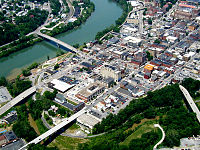
Top subjects The Dominion Post • Harner Homestead • Monongalia Arts Center • Morgantown High School • Morgantown Personal Rapid Transit • Mountain Line Transit Authority • Suncrest Middle School • University High School • Walters House • West Virginia UniversityNeighborhoods Greenmont • Jerome Park • The Milegorund • North Hills • Sabraton • Second Ward • South Hills • South Park •Suncrest • Sunnyside • Wiles Hill • WoodburnSuburbs Categories:- Educational institutions established in 1867
- Big East Conference schools
- Land-grant universities and colleges
- Education in Monongalia County, West Virginia
- Universities and colleges in West Virginia
- West Virginia University
- Public universities
- Oak Ridge Associated Universities
- Association of Public and Land-Grant Universities
- North Central Association of Colleges and Schools
- Buildings and structures in Monongalia County, West Virginia
- Visitor attractions in Monongalia County, West Virginia
Wikimedia Foundation. 2010.

